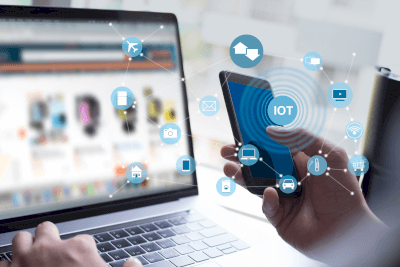What Is IoT?

IoT is a technology that enables not only devices used by humans but also various other objects to be connected to the Internet and to exchange information with each other. IoT is an abbreviation for “Internet of Things”.
By connecting various devices to the Internet, various services and businesses that were not possible in the past will be created. For example, by connecting devices such as automobiles and home appliances to the Internet, they can be operated remotely, automatically collect information, and are able to analyze it.
Uses of IoT
IoT is used in many fields, including medicine, logistics, manufacturing, agriculture, and transportation.
1. Healthcare
In the medical field, the health status of patients can be monitored in real time. For example, the occurrence of heart attacks and strokes can be predicted and early treatment can be provided.
2. Logistics
In the logistics field, inventory and delivery management can be made more efficient. For example, the system can determine the location of products in a warehouse for efficient inventory management.
3. Manufacturing
In the manufacturing industry, monitoring and quality control of production lines can be made more efficient. For example, it can predict the failure of equipment on the production line and perform preventive maintenance.
4. Transportation
In the transportation sector, it can reduce traffic congestion and promote safe driving. For example, automated driving technology can reduce the burden on drivers and contribute to safe driving.
5. Home
Examples of applications in the home include smart home systems that allow home appliances to be controlled from a smartphone.
Principles of IoT
IoT requires four elements: objects, sensors, means of communication, and applications. The IoT system is constructed by combining these elements.
1. Objects
Objects are the physical objects to be controlled in an IoT system. Examples include automobiles, home appliances, vending machines, and industrial equipment.
2. Sensors
Sensors measure physical quantities around objects such as temperature, humidity, and illumination. By equipping objects with sensors, various types of information can be obtained.
3. Means of Communication
Means of Communication is a means of exchanging data between IoT devices and between IoT devices and cloud services. To connect objects to the Internet, conventional Wi-Fi, 4G, and 5G communications consume a lot of power and are not suitable for objects that are battery-powered and operate for long periods of time.
On the other hand, the amount of data and transfer speeds are not so large and fast, with a few exceptions. LPWA (Low Power Wide Area) has been proposed as a communication method suitable for such IoT, and is still in the development stage.
4. Application
An application is a program for controlling, analyzing, and displaying IoT systems. For example, smartphone applications and web applications fall under this category.
Characteristics of IoT
IoT technology can be broadly divided into three categories: IoT to control things, IoT to understand the status of things, and IoT to communicate with other things.
The three main types of IoT technologies are:
1. Controlling Things
IoT technology can be used to control objects located at a distance via the Internet. For example, it is possible to control home appliances from a smartphone or remotely control multiple agricultural machines from a PC.
2. Knowing the Status of Objects
By utilizing IoT technology, it is possible to grasp the status of objects and their surroundings in real time using sensors and other devices. For example, the air pressure and temperature of automobile tires can be monitored in real time, and maintenance can be performed at the appropriate time.
3. Linkage of Objects
By utilizing IoT technology, multiple objects can communicate with each other and work together. For example, a car and a traffic control system or multiple home appliances in the home can exchange information with each other to make life more comfortable and driving more efficient.